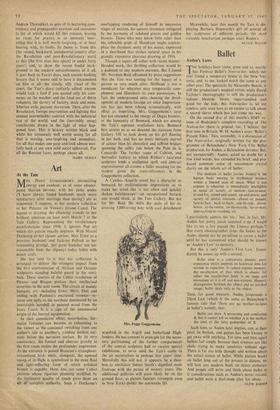Art
At the Tate
`RS. PEGGY GUGGENHEIM'S unremitting energy and candour, as of some emanci- pated Shavian heroine, with her pithy asides (`I have always found husbands much more satisfactory after marriage than during') are as renowned, I suppose, as her modern collection in her Palazzo on Venice's Grand Canal. The legend is drawing the elbowing crowds to her brilliant selection on loan until March 7 at the Tate Gallery. Representing the revolutionary manifestations since 1910, it ignores Pop art which this patron vocally deplores. With Marcel Ducharnp as her closest adviSer, Max Ernst as a previous husband, and Jackson Pollock as her resounding prot6g6, this great launcher not un- reasonably finds the slipways today laden with minor craft.
She has seen to it that her collection is arranged to deliver the strongest impact from the first confrontation of African and Oceanic sculptures standing baleful guard in the vesti- bule. These sources of the Cubist revolution of Picasso and Braque preface their intellectual severities in the next room. The circuit of mainly fantastic art--including Ernst, Miro, Dali and ending with Paolozzi's encrusted monster—re- turns one aptly to the vestibule dominated by an inscrutable hornbill in painted wood from the Ivory Coast. It is a sign of the immemorial origin of the Surreal imagination.
In their cumulative effect, nevertheless, Sur- realist fantasies can become as exhausting to the viewer as the continual switching from one author's tale to another's, yielding darkest cur- rents below the narrative surface. By its very consistency, the formal and abstract gravity in the first room makes the profounder impression. At the entrance is poised Brancusi's triumphant, streamlined bird; while, alongside, the upward sweep of its flight is symbolised in the most fluid and light-reflecting form of which polished bronze is. capable. Here, too, are some Cubist pictures whose rigorous planning mollified by the instinctive quality of touch gives them an air of complete authority. Such is Duchamp's
overlapping rendering of himself in successive stages of motion, his austere invention mitigated by the harmony of subdued greens and golden browns. Those who may know little other than the inflexible grids of Mondrian might contem- plate the rhythmic unity of his ocean, expressed in a shorthand that evokes natural space in his grandly expansive charcoal drawing of 1914.
Though it tapers off rather with recent thinner- blooded work, this thrilling collection would be a godsend to any modern museum. But I found Mr. Norman Reid affronted by press suggestions that the Tate was touting for the legacy of a patron so very much alive. Millbank is not a mendicant for whatever may temporarily com- plement and illuminate its own possessions. In fact, the underground suite showing the devel-, opment of modern foreign art since Impression- ism has just been rehung systematically, with effect as inspiriting. Mrs. Guggenheim's taste has not extended to the energy of Degas bronzes, or the humanity of Bonnard, which are among the Tate's supreme revelations here. Bonnard first arrests us as we descend the staircase from Gallery VII to look down on his girl floating in her bath, and has no more intricate marvel of colour than his chocolate and saffron bridges spanning the milky tide below the Pont de la Concorde. The further range of Cubism, and Surrealist fantasy to which Richier's lacerated sculpture lends a malignant spell, and abstract expressionism all assume a fuller meaning for the student given the cross-references in the Guggenheim collection.
A Cynthia Asquith novel has a character so bemused by multitudinous impressions as to make her mind like 'a too often and quickly shaken kaleidoscope—an occupational hazard,• one would think, at the Tate Gallery. But not for Mr. Reid. He shifts the units of his in- creasing 5,000-strong host with cool detachment
Mrs. Peggy Guggenheim
acquired in the Argyll and Sutherland High- landers. He has consent in principle for the neces- sary partitioning of the further compartment of the central sculpture hall to receive special exhibitions, to serve until the Tate's castle in the air materialises in perhaps five years' time. Mercifully this will not, it appears, be a shoe- box to annihilate Sidney Smith's dignified stone frontage with the patina of seventy years. Tice additional galleries will most likely be on the ground floor, as picture fanciers (strangely even in New York) dislike the automatic lift. Meanwhile, later this month the Tate is dis- playing Barbara Hepworth's gift of several of her sculptures of different periods, the most valuable benefaction perhaps since Rodin's.
NEVILE WALLIS






























 Previous page
Previous page